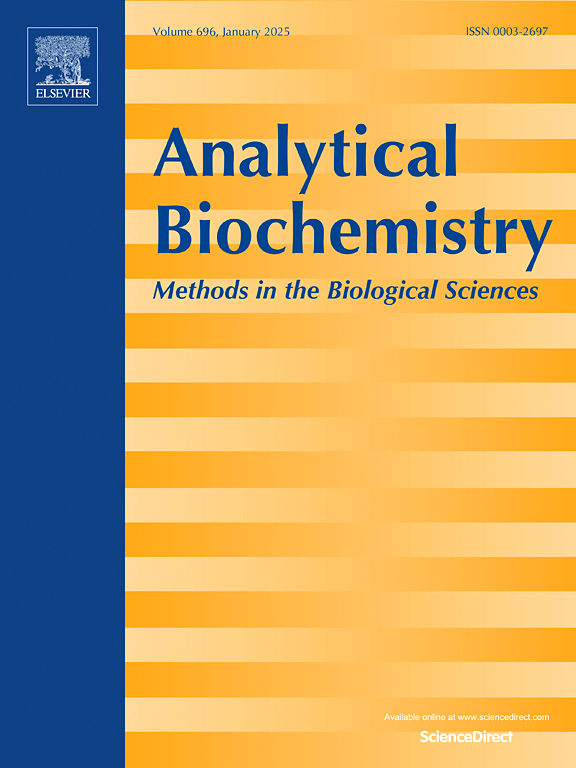Highly sensitive luciferase-based assay with red fluorescent protein expression for accurate quantitative monitoring and real-time visualization of cell invasion
IF 2.5
4区 生物学
Q2 BIOCHEMICAL RESEARCH METHODS
引用次数: 0
Abstract
Background
Traditional migration and invasion assays like scratch, Transwell, and Boyden chamber are widely used but have disadvantages such as being time-consuming, lacking real-time monitoring, and relying on endpoint measurements. We addressed these limitations by developing a novel fluorescent and luciferase-based invasion assay.
Materials and methods
Three stable cell lines co-expressing the red fluorescent protein dTomato, and secreting luciferase were generated based on Caco-2, MDA-MB-231 and HEK293T cells. Transwell chamber membranes were coated with Matrigel for invasion assay, onto which the modified cells were seeded. To simulate non-invasive and invasive conditions, chambers were incubated for 48 h in FBS-free or FBS-supplemented medium. Following incubation, the Matrigel along with non-invasive cells were removed, and the chambers washed before being transferred into fresh media for 24 h allowing the cells to secrete luciferase. Luciferase activity was measured and compared to traditional cell counting invasion assay, with further confirmations through Z-stacking and microscopic fluorescent imaging.
Results
Our results demonstrated that luciferase activity accurately correlates with cell count. Applying luciferase efficiently quantifies variation in cell invasion with higher sensitivity, hence improving detection of low-level invasion as compared to cell counting techniques based on nuclear staining. The expression of the fluorescent dTomato protein proved ideal for real-time visualization of invading cells.
Conclusion
Overall, using luciferase and dTomato co-expressing cells for invasion assay showed reliable and accurate measurements of variations in cell invasion patterns. Introducing these cells reduced time-consuming steps, improved sensitivity, and endpoints measurements, while being capable of real-time visualization, providing advantages over traditional methods.

高灵敏度荧光素酶为基础的实验与红色荧光蛋白表达准确定量监测和实时可视化的细胞入侵。
背景:传统的迁移和侵袭试验(如scratch、Transwell和Boyden chamber)被广泛使用,但存在耗时、缺乏实时监测、依赖于终点测量等缺点。我们通过开发一种新的荧光和荧光素酶为基础的入侵试验来解决这些局限性。材料与方法:以Caco-2、MDA-MB-231和HEK293T细胞为基础,制备了3株共表达红色荧光蛋白dTomato并分泌荧光素酶的稳定细胞系。在Transwell室膜上涂上一层Matrigel进行侵袭试验,并将修饰的细胞播种在其上。为了模拟无创和有创条件,实验室在不含fbs或添加fbs的培养基中孵育48小时。孵育后,除去基质和非侵入性细胞,清洗室,然后将细胞转移到新鲜培养基中24小时,使细胞分泌荧光素酶。测量荧光素酶活性,并与传统的细胞计数侵袭试验进行比较,并通过z堆叠和显微荧光成像进一步证实。结果:荧光素酶活性与细胞计数有准确的相关性。应用荧光素酶以更高的灵敏度有效地量化细胞侵袭的变化,因此与基于核染色的细胞计数技术相比,提高了对低水平侵袭的检测。荧光dTomato蛋白的表达被证明是实时可视化入侵细胞的理想选择。结论:总体而言,利用荧光素酶和dTomato共表达细胞进行侵袭实验,可以可靠、准确地测量细胞侵袭模式的变化。引入这些单元减少了耗时的步骤,提高了灵敏度和端点测量,同时能够实时可视化,与传统方法相比具有优势。
本文章由计算机程序翻译,如有差异,请以英文原文为准。
求助全文
约1分钟内获得全文
求助全文
来源期刊

Analytical biochemistry
生物-分析化学
CiteScore
5.70
自引率
0.00%
发文量
283
审稿时长
44 days
期刊介绍:
The journal''s title Analytical Biochemistry: Methods in the Biological Sciences declares its broad scope: methods for the basic biological sciences that include biochemistry, molecular genetics, cell biology, proteomics, immunology, bioinformatics and wherever the frontiers of research take the field.
The emphasis is on methods from the strictly analytical to the more preparative that would include novel approaches to protein purification as well as improvements in cell and organ culture. The actual techniques are equally inclusive ranging from aptamers to zymology.
The journal has been particularly active in:
-Analytical techniques for biological molecules-
Aptamer selection and utilization-
Biosensors-
Chromatography-
Cloning, sequencing and mutagenesis-
Electrochemical methods-
Electrophoresis-
Enzyme characterization methods-
Immunological approaches-
Mass spectrometry of proteins and nucleic acids-
Metabolomics-
Nano level techniques-
Optical spectroscopy in all its forms.
The journal is reluctant to include most drug and strictly clinical studies as there are more suitable publication platforms for these types of papers.
 求助内容:
求助内容: 应助结果提醒方式:
应助结果提醒方式:


